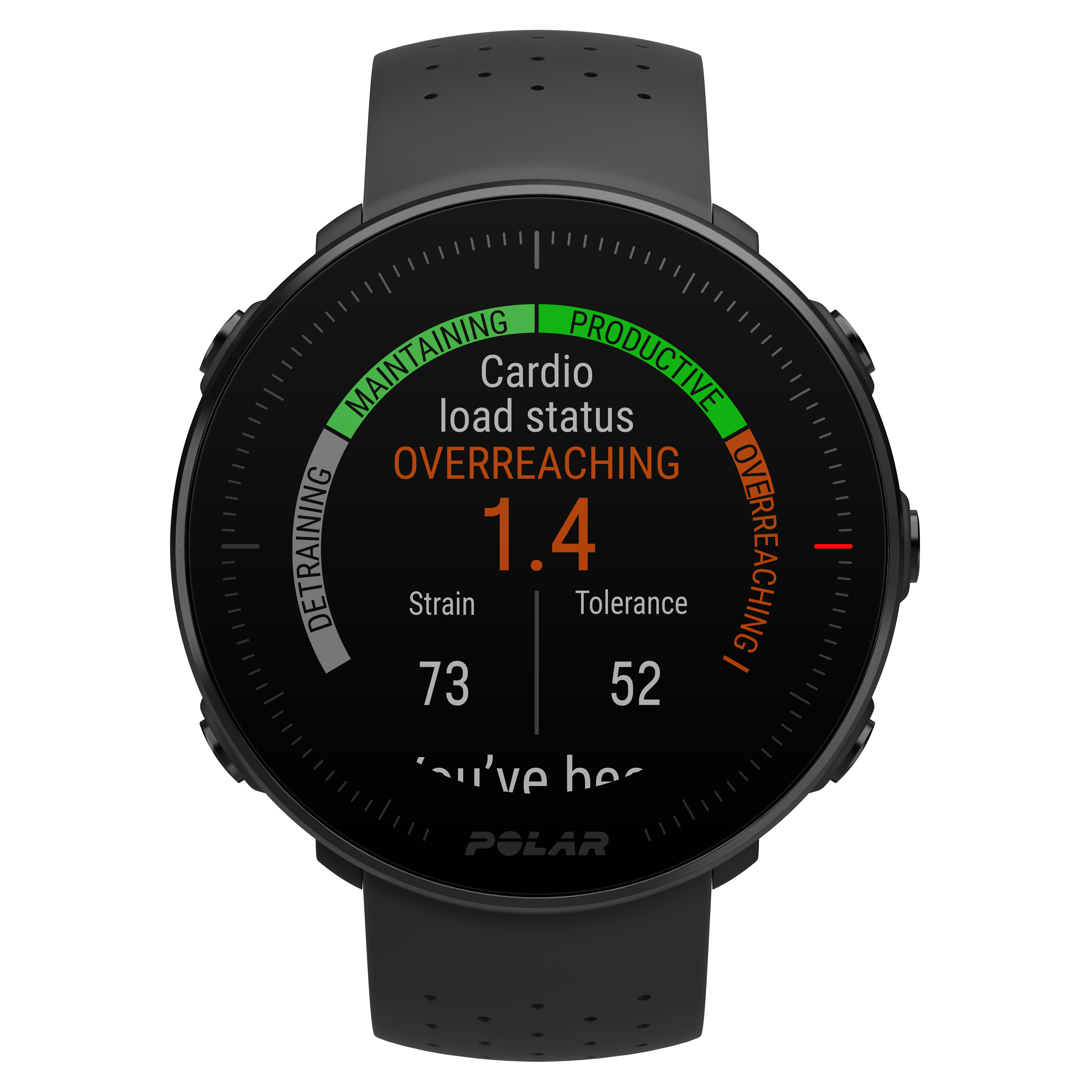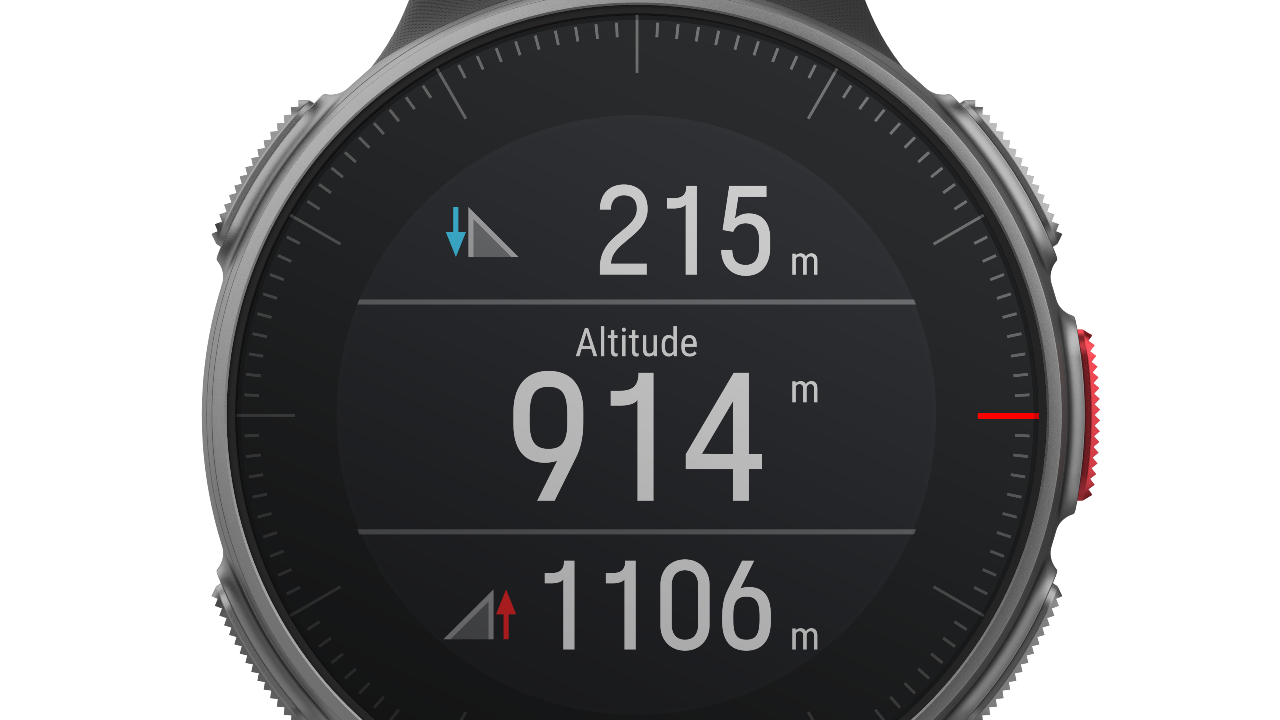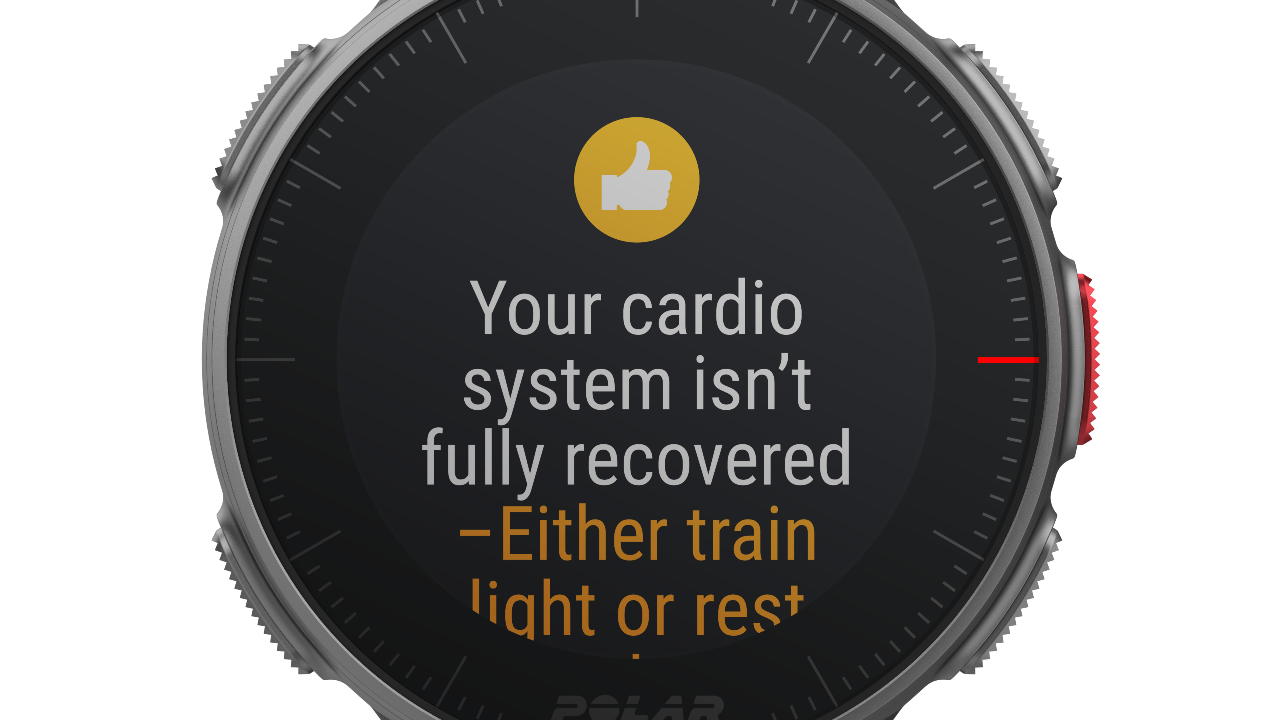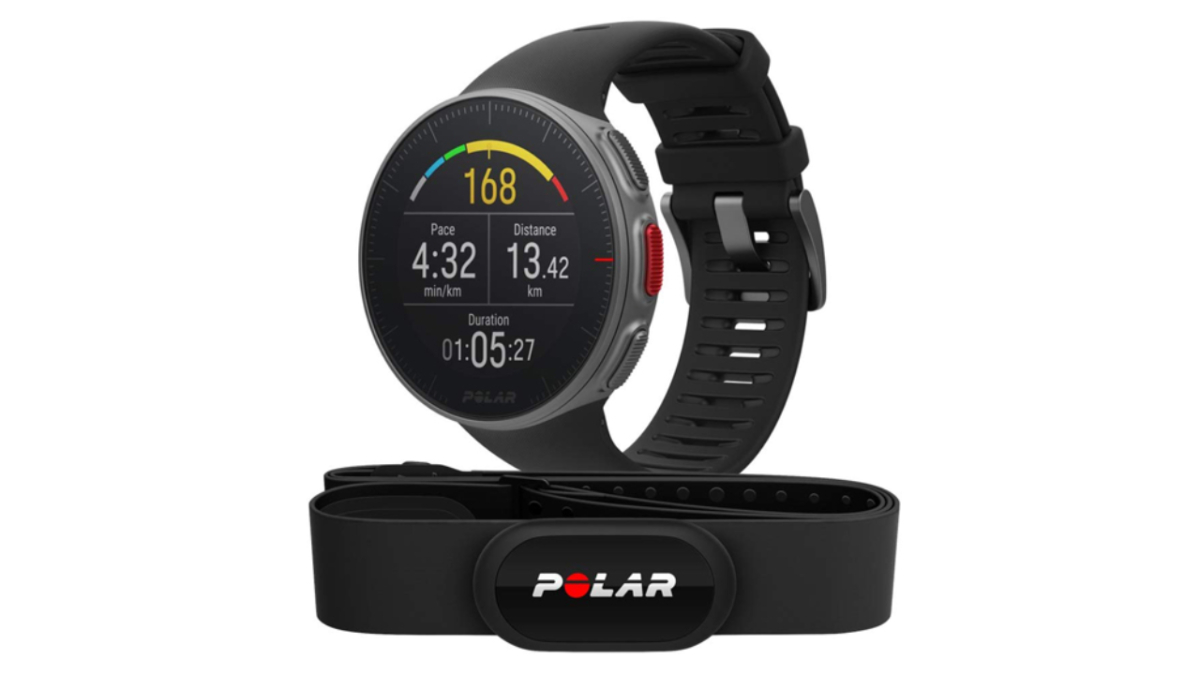Our Verdict
When Polar launched its flagship Vantage V watch in late 2018 I was unimpressed. Despite some novel features, it botched the basics – namely distance and heart rate tracking – and lacked features that were present on Polar’s cheaper watches. In the year since, however, Polar’s multiple software updates have turned it from one to avoid into one of the best multisport watches available.
For
- Running power is available without the need for extra sensors
- Design
- Battery life
- Everyday activity tracking
Against
- Unreliable heart rate tracking when running
- Unresponsive buttons
- Polar’s app and the Polar Flow website are confusing
You can trust Coach
Should I consider buying something else?
At its RRP of £439 the Vantage V occupies the space between top-end Garmin watches like the Forerunner 945 and Fenix 6 Pro – which are among the best fitness trackers and offer more features and better design – and mid-range watches like the Garmin Forerunner 245 Music and Coros Apex. That’s about right: the Vantage V is more or less a mid-range watch with a couple of extra features, most notably running power.
However, the Vantage is usually available for between £350 and £370, where it offers excellent value – although there’s a good argument for buying a mid-range watch like the Forerunner 245 Music or Coros Apex, which cost £300. Unless you’re taken with the idea of running power, I’d lean towards the 245 Music myself, and it’s clearly the better choice if you want music on your watch.
One other good option is the Garmin Fenix 5 Plus series. Now the Fenix 6 range has been released, the 5 Plus watches are ripe for deals that will bring them close to the price of the Vantage V. Though the RRP of the watches remains at £599, you could find the 5 Plus for £399 in the Black Friday sales. Any of the watches in the range (the 5S Plus, 5 Plus and 5X Plus) offer considerably more than the Vantage V, with colour maps, superb sports tracking and smart features like music storage.
Polar Vantage V In-Depth
Running With The Polar Vantage V
In my first go-round with the Vantage V I found it desperately lacking when it came to run tracking, with the most egregious error being inaccurate distance tracking. For example, it came up very short when I tracked a parkrun that had two hairpin bends in it, suggesting it isn’t taking GPS readings frequently enough to account for sharp turns. I’ve tried several other watches at that particular parkrun – the Apple Watch 4, Garmin Fenix 5 Plus and Garmin Fenix 6 Pro – without having the same problem.
However, a recent update has fixed this problem and I’ve tested the Vantage multiple times on runs under tree cover and even on the track without noticing any unforgivable GPS discrepancies compared with a Garmin watch paired with a calibrated footpod.
That’s not to say all the problems with the watch have been fixed. Heart rate accuracy is still a crapshoot. The Polar Precision Prime sensor in the watch is meant to be the company’s most accurate optical monitor yet, but I found it often lost my heart rate during runs, dropping by around 20bpm for a couple of minutes or spiking to ridiculously high levels for 30 seconds or so, before returning to the correct reading. During a steady effort this is a mild annoyance, but it’s maddening when trying to base an interval session on heart rate.
I strongly recommend only considering the watch and chest strap sensor package in order to take advantage of the advanced training load and recovery analysis features. These link directly to your effort level during workouts, based on heart rate, so you need accurate readings or they become skewed and largely useless.
Sign up for workout ideas, training advice, reviews of the latest gear and more.

Once you’ve used the Vantage V for a week you’ll start getting feedback on your training, in terms of the load placed on your cardiovascular system and your tolerance to that load. You’ll find this in the Polar Flow app and on the website – there’s not a huge amount of info on the watch itself. In the cardio load section you’ll be told if your training is productive in the sense of making you fitter, or if you’re overdoing or underdoing it. The longer you use the watch for and the more (accurate) data it gleans from your training the more useful this cardio load report becomes, and it can be genuinely useful in helping you to avoid risking injury by pushing too hard.
The Polar Vantage V also has another way to measure your effort level – running power. This is the first device to offer a power stat without the need for any extra sensors, and it works. Once you work out how the figures relate to your running, you can use power to pace your training runs and races. The Vantage V can also break down your power by zone, so you can use it in a similar way to heart rate.

But will you? Are runners really going to use it to pace their races instead of, well, pace? It’s a fairly new idea in running and this is the first time it’s been made so easily available, so maybe it will catch on fast if people start producing negative splits in races where power has helped them gauge their effort level perfectly. However, in the year since the Vantage V launched I’ve seen little sign of runners really embracing power, and I barely gave it a second glance after testing it out a few times with the Vantage V.
It’s perhaps a measure that triathletes will take to more easily when running, since power is widely used in cycling, but I’ll confess I’d find it very hard to try to run a PB based on power rather than trying to hit a pace that directly links to the time in question, and for easy efforts I don’t see power being a significant upgrade on just using heart rate to ensure you’re not overdoing it.
The Vantage V’s updates has also brought an intervals mode to the watch, along with structured workouts and breadcrumb navigation. These are essential features for a flagship running watch, especially as you’ll find them in most mid-range and even budget running watches, and they are very useful.
One thing that Polar will not be able to update remotely, unfortunately, is the hardware of the Vantage V. It’s a little clunky to use, with stiff buttons and a fairly dull screen that’s sometimes tricky to see while on the run. I much prefer interacting physically with Garmin’s Forerunner or Fenix, or Coros’s Apex, and it’s one of the Vantage’s biggest failings as a flagship watch you’re expecting to wear at all times and train with most days.
Cycling With The Polar Vantage V
The Polar Vantage V offers cyclists a little less than runners, mainly because a wrist-based cycling power measurement isn’t possible, although you can pair a cycling power meter with the watch if you have one.
The tracking experience is generally the same as running, though interestingly I didn’t have the same heart rate accuracy issues when cycling as I did when on foot. The sample size is smaller – I run more than I ride – but the heart rate readings didn’t drop to an unexpectedly low number, matching up reasonably well with a chest strap’s readings.
Your rides also inform the recovery and training feature. If the heart rate tracker is working for you then these can give a decent picture of the strain your training is putting on your body.
Swimming With The Polar Vantage V
Pool and open-water swimming are both tracked by the Vantage V, which also has dedicated triathlon modes for on- and off-road events. You can set the pool length to one of the usual standards or enter it yourself, although the scale goes all the way up to an improbable 250m but bottoms out at 20m. We suspect you’re more likely to come across a pool shorter than 20m than one longer than 200m, but there you go.
The pool swim tracking on the Polar is excellent. While you can’t display swim-specific stats during your session beyond distance, time and pace, after you finish you get an impressively thorough breakdown of your session including stroke rate per length or minute, your SWOLF score, and the type of stroke you used. I found stroke recognition was accurate even with my imperfect technique. There’s also a breakdown of how long you rested for between lengths or sets of lengths, which is recorded automatically so you don’t have to press the lap button each time, and you can analyse each set in detail including pace (per length or set) and heart rate, although the latter isn’t tremendously accurate in the water as you’d expect.
Using The Polar Vantage V To Track Activity
When you set up your profile on the Vantage V you get to choose between three activity goals. Level 1 is aimed at mostly sedentary office workers; level 2 is for people who spend a lot of the day on their feet; and level 3 is for those who are very keen on their chosen sport.
One thing I particularly liked is that everything you do counts towards the goal – everyday activity stats like steps, calories and active minutes as well as sports tracking. In a similar vein, your everyday activity contributes to your recovery status. If you’re on your feet all day that’s clearly going to affect your recovery time almost as much as a half-hour run at lunch, and Polar does well to take this into account.
In the Polar Flow app you get an attractive circular graph that shows your day colour-coded by how active you were – darker blue means more active. It’s a good representation of your day, and clearly highlights if you’ve done one big run or ride then sat still for the rest of the time, which isn’t the smartest way to stay active. There are also inactivity alerts, though these seem pretty generous in my experience. I found I could sit for long periods without triggering any.
The level 3 target is sufficiently difficult to hit that it can motivate very active people. I run almost every day and log 90-100km a week, but my runs alone tended to not be enough to hit 100% of my activity goal each day, and I had to also stay active throughout the rest of the day. That said, I – like most keen amateurs – probably don’t care all that much about the activity goal on a watch; what matters to me is completing my planned training that day, even if that means putting my feet up because it’s a rest day.
The Vantage V doesn’t do anything especially novel with its everyday activity tracking, but it does make itself useful enough that you’ll be keen to dive into the stats between your training sessions.
Sleep Tracking With The Polar Vantage V
One area where Polar is streets ahead of Garmin, Suunto and Coros is sleep tracking. Across its range of watches, Polar offers impressive detail on your night’s rest and feeds that into its recommendations on how you should train the following day.
This is through the Nightly Recharge feature, which gives a rating of how well you have slept and also how well your autonomic nervous system (ANS) has recovered. The latter is based on how much time you spend in rest and digest mode (parasympathetic nervous system) compared to fight or flight mode (sympathetic nervous system), and measures physical stress on the body using your heart rate variability, heart rate and breathing rate.
Each morning you get a sleep rating and an ANS charge rating, compared with your previous 28-day average. This shows up on the watch as a simple measure like “very good” or “good” if it’s been a good night on both counts, or “poor” or “compromised” if it hasn’t been. The combination of both sleep and ANS is useful because it’s possible to black out for a full night’s sleep without getting much good-quality, restorative sleep. After a night on the sauce, for example, your body will spend much of the night processing the alcohol, so your ANS recovery will be poor even if you log eight hours of sleep.
The Vantage V uses this information to give recommendations about how you should train the next day, perhaps suggesting you ease off if it’s been a particularly bad night. In general the watch always told me I could train, even if I’d had an awful night by its measures, but it would gently suggest an easier session if that was the case.

You also get a detailed sleep score based on six factors across three categories: amount, solidity and regeneration. These are all engagingly presented in the Polar app through a colour-coded six-pointed star, and there’s a simple sleep score out of 100 if you just want a quick rating at a glance. This easy-to-understand way of displaying information is something I’d love Polar to bring to the training history and cardio load sections of the app and website, because those are areas more people will look at and they’re a little tricky to get your head around at times.
The Vantage still sometimes struggled to track my sleep perfectly, but it was more accurate than any Garmin device I’ve worn, and the feedback provided is of a completely different order. Polar seems to really get how important sleep is to your training schedule.
However, the one major flaw in all of this is that the Vantage V isn’t very comfortable to wear at night. The silicone strap gets hot and the devices sticks out a long way from the wrist, so on several occasions I’d find it too annoying and take it off. It’s a trade-off that you’ll have to decide on each night: do you want the sleep stats or the relief of not wearing a chunky tracker at night?
The Polar Flow Website And App
The Polar Flow training platform comprises both a smartphone app and a website. The latter gives the clearest picture of your fitness or training load over time, but you do get a good snapshot of your cardio load in the app, along with a lot of detail on any individual training sessions and your sleep stats.
The experience isn’t as straightforward as on Garmin Connect or Fitbit’s app, and even on the website there’s a lot of digging to be done to find the stats you’re after at first. This will be off-putting for people who are unfamiliar with tracking technology, especially as you can’t just get by with the app and the watch. The flipside is that stat obsessives will enjoy spending some time delving into the website.
I also found that syncing the Vantage V with the app was sluggish, and if I wanted to get the data on a training session over immediately, I’d have to hold down the back button on the watch. Automatic syncing does happen after a while but it’s not immediate, while the opposite is the case with most wearables, and who wants to wait a few hours to get their activity on Strava? Not me.
How Often Am I Going To Have To Charge It?
Battery life on the Vantage V is listed at an impressive 40 hours in training mode, with GPS and heart rate turned on. If you enable smartphone notifications and continuous heart rate tracking outside of exercise you’ll drain it a lot faster, but you’ll still get a week out of the device between charges, which is great.
Where Can I Wear It Without People Laughing At Me?
The Vantage V has a sleek design that means you can wear it everywhere. It’s certainly a big step up in the looks stakes from previous Polar watches, especially the clunky hunk of plastic that was the M430 (an excellent tracker – looks aren’t everything). However, when you interact with the Vantage V the design is less impressive. The buttons are stiff and take a millisecond too long to respond and the touchscreen is quite unresponsive – in fact I found it pretty pointless.
It’s not an especially bright screen either. It feels a bit cheap, frankly, when it is anything but. The Vantage V looks smarter than past Polar devices, but it doesn’t come close to the premium feel of watches like the Garmin Fenix 6 Pro, or even the Coros Apex, which is under £300.

Nick Harris-Fry is a journalist who has been covering health and fitness since 2015. Nick is an avid runner, covering 70-110km a week, which gives him ample opportunity to test a wide range of running shoes and running gear. He is also the chief tester for fitness trackers and running watches, treadmills and exercise bikes, and workout headphones.

